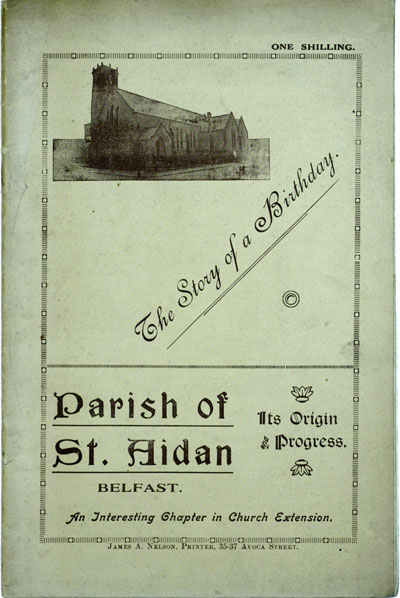
PARISH OF ST. AIDAN, BELFAST
Its Origins and Progress
An Interesting Chapter in Church Extension
James A. Nelson, Printer, 35-37 Avoca Street
-- -- -- -- -- -- -- -- -- -- -- -- -- -- --
THE PARISH CHURCH OF ST. AIDAN lies in a district which a century ago was nothing but gardens, orchards and green fields. Pertaining to the Marquis of Donegall the whole area on that side of the present great and growing Metropolis of Ulster was leased to a sturdy and progressive tenantry, most of whom were identified with large and prosperous industrial or commercial enterprises in the town. These included the Thompsons of Fountainville, the Leggs of Malone, and the Templetons of Orange Grove, who were related to one another, also to the Stewarts of Ballydrain, and the Grimshaws of Ballygolan; one of whom, Conway a go-ahead merchant, with John and William Murphy, connections of his own, erected the Linfield Mill.
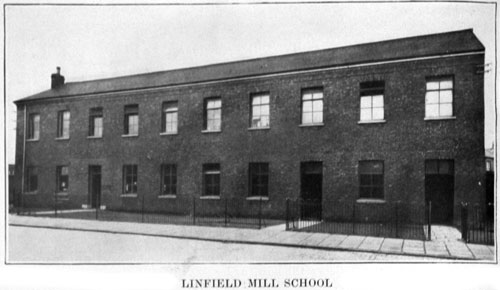
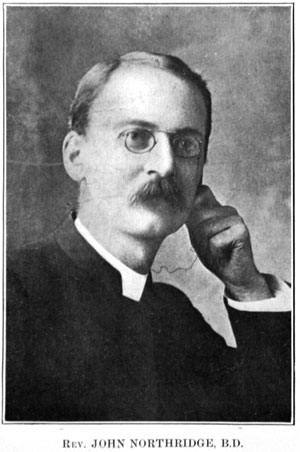 Orange Grove, the residence of the Templetons, was occupied in Revolution days by a family named Eccles, the head of which, a forbear of their own, entertained the Prince of Orange on his march to the Boyne, hence probably the name -- Orange Grove. John Templeton, a scion of the same house, who passed away in 1825, at the age of four-score years, was a naturalist of world-wide fame.
Orange Grove, the residence of the Templetons, was occupied in Revolution days by a family named Eccles, the head of which, a forbear of their own, entertained the Prince of Orange on his march to the Boyne, hence probably the name -- Orange Grove. John Templeton, a scion of the same house, who passed away in 1825, at the age of four-score years, was a naturalist of world-wide fame.
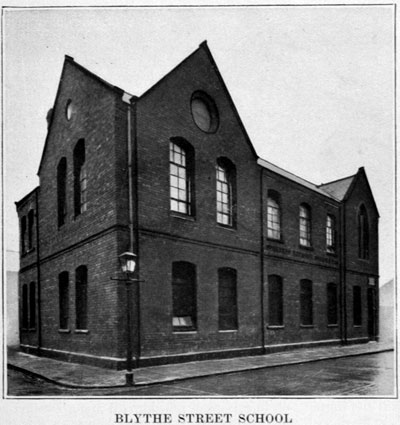
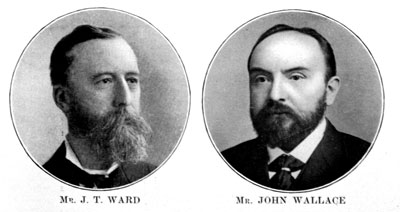 At the beginning of the past century one of these Thompsons advertised a farm containing 10 acres, and embracing, according to a reliable authority, the properties now known as The Crescent, Fountainville and neighbouring district, which would include Sandy Row, and therefore the site of the present Church. It is in truth at present--about 1877, says Benn, "nearly, if not altogether, the most valuable ground in Belfast as a private quarter." Yet this farm was let in 1802 for £30 a year. Fruit Hill, Malone, also announced for sale at the same time containing 12 acres for £8 15s. a year. The yearly value of both places now would be beyond our power of estimating.
At the beginning of the past century one of these Thompsons advertised a farm containing 10 acres, and embracing, according to a reliable authority, the properties now known as The Crescent, Fountainville and neighbouring district, which would include Sandy Row, and therefore the site of the present Church. It is in truth at present--about 1877, says Benn, "nearly, if not altogether, the most valuable ground in Belfast as a private quarter." Yet this farm was let in 1802 for £30 a year. Fruit Hill, Malone, also announced for sale at the same time containing 12 acres for £8 15s. a year. The yearly value of both places now would be beyond our power of estimating.
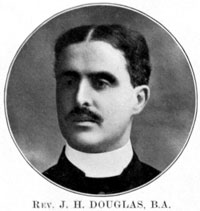 Prior to 1877 a large field spread in an unbroken expanse from the back of the Linen Hall to the edge of the Blackstaff, called M'Clean's field or fields. The part of it adjoining the Malone Road, and in a line with the five very large houses in Donegall Square North, was enclosed by a low brick wall; a turnstile in this wall served as an entrance to the ground which was crossed by a footway to the Malone Road. Thus we have presented to us a fairly clear view of the landscape on the east side of Sandy Row in the early part of the century that's gone. Open fields stretched almost without interruption to the brink of the Blackstaff. This stream in times of drought babbled beautiful and Iimpid, and in seasons of rain hurried along swollen and turgid, to flood, with waters carried from the mountain sides, low lying districts.
Prior to 1877 a large field spread in an unbroken expanse from the back of the Linen Hall to the edge of the Blackstaff, called M'Clean's field or fields. The part of it adjoining the Malone Road, and in a line with the five very large houses in Donegall Square North, was enclosed by a low brick wall; a turnstile in this wall served as an entrance to the ground which was crossed by a footway to the Malone Road. Thus we have presented to us a fairly clear view of the landscape on the east side of Sandy Row in the early part of the century that's gone. Open fields stretched almost without interruption to the brink of the Blackstaff. This stream in times of drought babbled beautiful and Iimpid, and in seasons of rain hurried along swollen and turgid, to flood, with waters carried from the mountain sides, low lying districts.
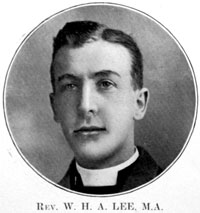 Evidence of the once rural character of St. Aidan's Parish was easily discernable when the Church Extension came and decided to commence their operations. All through the long years the site of the new Church unmistakably retained the appearance, if not entirely the outstanding features, of an orchard, and this enclosure must have been at one time as we have already indicated, on the Fountainville or Malone property. A considerable amount of building had been done in Sandy Row, but traces still lingered, here and there, pointing to a verdant past.
Evidence of the once rural character of St. Aidan's Parish was easily discernable when the Church Extension came and decided to commence their operations. All through the long years the site of the new Church unmistakably retained the appearance, if not entirely the outstanding features, of an orchard, and this enclosure must have been at one time as we have already indicated, on the Fountainville or Malone property. A considerable amount of building had been done in Sandy Row, but traces still lingered, here and there, pointing to a verdant past.
St. Aidan's Parish, curved out of Andrew's, came to be formed in an unexpected way. Inspired by the Lord Bishop of the Diocese, Bishop Welland, a movement was set on foot to bring the ministries of the Christian religion to the non church-going masses. One of the first places to receive attention was Sandy Row district. Among the distinguished laymen who acted on the Committee were -- Messrs. J.T. Ward, W.R. Patterson, R.L. Hamilton, Thomas Browne, John Corbett, W.T. Coates. It was felt St. Andrew's was unequal to the task of meeting the spiritual needs of all belonging to the Church of Ireland who had congregated into the new streets which had sprung into existence In that area.
St. Thomas' congregation, rich, and missionary in spirit, saw an opportunity to advance the Redeemer's Kingdom, and so Mr. J.T. Ward, one of its members, and others, began most willingly to work.
 A simple Bible Class in a cottage home, 20 Utility Street, carried on by Mr. Ward through a long period of years, was the commencement of this effort. Afterwards this worthy citizen and earnest Christian gentleman, along with Mr. R Crawford of Malone Avenue, conducted an intensive Campaign in the Linfield Grounds. The Meetings, simple mission services, were held in a tent owned by Mr. Crawford. Mr. William Coates, a director of the Linfield Spinning & Weaving Co., gave them every possible encouragement in their labours, and eventually granted the use of Linfield Mill School, where the Meetings were continued. By this time the Rev. John Northridge, B.A., Curate of St. Thomas', had definitely become identified with the new movement, and had been conducting Open-Air Meetings in Sandy Row with marked success. Mr. Northridge, a man endowed with unusual gifts of leadership, combined with simple, earnest devotion to Jesus Christ, at once became the Inspiration and centre of the new enterprise. Under his guidance the work soon began to assume a permanent character. The first Services for Divine Worship were held in Linfield Mill School on Sunday, June 4th, 1893: 170 persons were present at the morning service, and 230 at the evening service. Thus commenced a work which has brought the blessing of the Gospel of Jesus Christ to a needy district and to hundreds of lives. The work proceeded with such abounding success that the Diocesan Council, by resolution on July 5th, 1893, decided upon the formation of a new Parish. This action was confirmed by the Representative Church Body a fortnight later, on July 19th, 1893, and the task of providing Church accommodation for the new congregation had to be faced.
A simple Bible Class in a cottage home, 20 Utility Street, carried on by Mr. Ward through a long period of years, was the commencement of this effort. Afterwards this worthy citizen and earnest Christian gentleman, along with Mr. R Crawford of Malone Avenue, conducted an intensive Campaign in the Linfield Grounds. The Meetings, simple mission services, were held in a tent owned by Mr. Crawford. Mr. William Coates, a director of the Linfield Spinning & Weaving Co., gave them every possible encouragement in their labours, and eventually granted the use of Linfield Mill School, where the Meetings were continued. By this time the Rev. John Northridge, B.A., Curate of St. Thomas', had definitely become identified with the new movement, and had been conducting Open-Air Meetings in Sandy Row with marked success. Mr. Northridge, a man endowed with unusual gifts of leadership, combined with simple, earnest devotion to Jesus Christ, at once became the Inspiration and centre of the new enterprise. Under his guidance the work soon began to assume a permanent character. The first Services for Divine Worship were held in Linfield Mill School on Sunday, June 4th, 1893: 170 persons were present at the morning service, and 230 at the evening service. Thus commenced a work which has brought the blessing of the Gospel of Jesus Christ to a needy district and to hundreds of lives. The work proceeded with such abounding success that the Diocesan Council, by resolution on July 5th, 1893, decided upon the formation of a new Parish. This action was confirmed by the Representative Church Body a fortnight later, on July 19th, 1893, and the task of providing Church accommodation for the new congregation had to be faced.
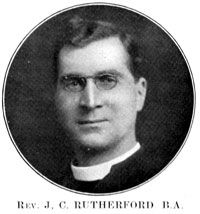 The site for the intended Church was secured in Blythe Street. A beginning was made with the erection of the present Parochial Schools on the opposite side of that thoroughfare. These, hurriedly completed, were opened on April 16th, 1894. It is interesting to note that of the teachers who took up duty at the opening of this school, one has just recently retired, Miss L. Greene, from the position of Principal of Junior School which she had occupied with distinction and acceptance during all these years. Miss Butler who also took up duty at the same time is still actively busy in the work of the school. The congregation used the new schools on Sundays for the purpose of public worship, and here the services became more inspiring and better attended than ever.
The site for the intended Church was secured in Blythe Street. A beginning was made with the erection of the present Parochial Schools on the opposite side of that thoroughfare. These, hurriedly completed, were opened on April 16th, 1894. It is interesting to note that of the teachers who took up duty at the opening of this school, one has just recently retired, Miss L. Greene, from the position of Principal of Junior School which she had occupied with distinction and acceptance during all these years. Miss Butler who also took up duty at the same time is still actively busy in the work of the school. The congregation used the new schools on Sundays for the purpose of public worship, and here the services became more inspiring and better attended than ever.
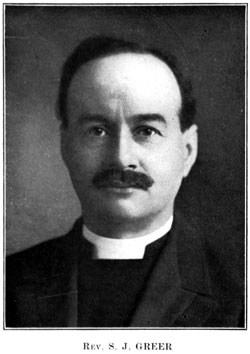 The first annual meeting of the congregation was held in the schools on Friday evening, September 21st, 1894, Rev. J. Northridge presiding, accompanied on the platform by neighbouring clergymen and friends. Mr. James Pryde, Rector's Churchwarden, stated the two main reasons for the success of the effort which had brought about the formation of St. Aidan's. The first was the help given by St. Thomas' Church. The second lay in the fact the Parish had been cradled in prayer. Mr. Wallace also spoke. The Revs. Dr. Spence, R.U. Greer, and N. E. Smith expressed themselves full of admiration and thankfulness to God for all that had been accomplished.
The first annual meeting of the congregation was held in the schools on Friday evening, September 21st, 1894, Rev. J. Northridge presiding, accompanied on the platform by neighbouring clergymen and friends. Mr. James Pryde, Rector's Churchwarden, stated the two main reasons for the success of the effort which had brought about the formation of St. Aidan's. The first was the help given by St. Thomas' Church. The second lay in the fact the Parish had been cradled in prayer. Mr. Wallace also spoke. The Revs. Dr. Spence, R.U. Greer, and N. E. Smith expressed themselves full of admiration and thankfulness to God for all that had been accomplished.
 On December 24th, 1894, Mr. Northridge was instituted by the Lord Bishop of the Diocese as first Incumbent of St. Aidan's Parish, a well-deserved promotion. The erection of the New Church in Blythe Street was at this date well advanced. The foundation stone was laid on Saturday, October 27th,. 1894, by the Most Rev. Dr. Gregg, Lord Primate of All Ireland. Though the weather was most unfavourable it did not prevent a large attendance of friends of the work. Among those present. in addition to the Lord Primate and the Lord Bishop of the Diocese (Right Rev. Dr. Weiland). were the Dean of Connor (Very Rev. C. Seaver), the Dean of Down (Very Rev. E. Maguire), Rev. Canon O'Hara, Revs. Dr. Spence. Dr. Riddall. Dr. Irvine, J. Northridge, Wm. Dowse, W.F. Garstin, N.E. Smith, Charles Scott, W. Williamson, C.E. Quin, W. Peoples, S.E. Cooney, J.B. Coates, J.A. Armstrong, J.E. Archer, R.U. Greer. R.E. Waters, Sir Wm. Q. Ewart, Bart., Wm. Henry Fitzgibbon, Esq, (County Court Judge), Mr. James Henderson, J.P. (later Knight and Lord Mayor), Mr. R. Atkinson, J.P., Mr. W.T. Coates, J.P., Mr. James Pryde and Mr. John Wallace (Churchwardens), Mr. J.T. Ward, and others.
On December 24th, 1894, Mr. Northridge was instituted by the Lord Bishop of the Diocese as first Incumbent of St. Aidan's Parish, a well-deserved promotion. The erection of the New Church in Blythe Street was at this date well advanced. The foundation stone was laid on Saturday, October 27th,. 1894, by the Most Rev. Dr. Gregg, Lord Primate of All Ireland. Though the weather was most unfavourable it did not prevent a large attendance of friends of the work. Among those present. in addition to the Lord Primate and the Lord Bishop of the Diocese (Right Rev. Dr. Weiland). were the Dean of Connor (Very Rev. C. Seaver), the Dean of Down (Very Rev. E. Maguire), Rev. Canon O'Hara, Revs. Dr. Spence. Dr. Riddall. Dr. Irvine, J. Northridge, Wm. Dowse, W.F. Garstin, N.E. Smith, Charles Scott, W. Williamson, C.E. Quin, W. Peoples, S.E. Cooney, J.B. Coates, J.A. Armstrong, J.E. Archer, R.U. Greer. R.E. Waters, Sir Wm. Q. Ewart, Bart., Wm. Henry Fitzgibbon, Esq, (County Court Judge), Mr. James Henderson, J.P. (later Knight and Lord Mayor), Mr. R. Atkinson, J.P., Mr. W.T. Coates, J.P., Mr. James Pryde and Mr. John Wallace (Churchwardens), Mr. J.T. Ward, and others.
The Lord Bishop, having spoken, presented the Lord Primate with a beautiful sliver trowel, while the Contractor made His Grace the recipient of a handsome mallet. With these the Lord Primate laid the foundation-stone, underneath which were placed copies of the Belfast News-Letter, The Northern Whig, The Belfast Telegraph and the Parish Magazine, together with a parchment scroll bearing the names of the Lord Primate, the Lord Bishop, Rev. J. Northridge, the Churchwardens (Mr. J. Pryde and Mr, J. Wallace), and the Architect, Mr. S.P. Close; and the Builder, Mr. Thomas M'Mullan. The new church, built of brick in early English style, was planned to seat 800 worshippers, but the Intention was to increase this accommodation. The estimated cost was £3,000, and the greater portion of this sum had still to be raised. On Saturday, March 23rd, 1895, the New Church was dedicated. The service at 4 O'clock, when there was a large attendance of Clergy and in addition to those who were present at the laying of the foundation stone, were the Archbishop of Dublin (The Most Rev. Dr. Plunket), The Dean of Cork (The Very Rev Dr. Mervyn Archdall), The Rev. Canon Crozier (Bishop's Chaplain), afterwards elevated to the Bishops' Bench, and later Lord Primate of all Ireland; the Revs. B. Banks, Canon Bristow, W.H. Davis, T. Forsyth, C.F. Lett, J.E. Peacocke, The Revs. Dr. Kane, George G. Mervyn, J.H. Mervyn, T. Dowzer, A.B. Archdall and F. Hall. The Rev. Canon O'Hara, and the Dean of Connor read the lessons, and the Archbishop of Dublin preached an impressive sermon based on the words of the 2sth verse of the 73rd Psalm, "It is good for one to draw near to God."
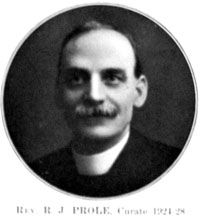 The Protestant, yet Catholic, character of the Church of Ireland was dwelt upon by the Archbishop. Once again His Grace was the preacher on the following morning. Referring to this great occasion in the history of St. Aidan's a writer in a morning paper remarked, "The presence of this distinguished prelate (the Archbishop), and that of the Dean of Cork who preached in the evening, is a sign of the union and sympathy between the North and South." It remains to acknowledge with sincere gratitude, the splendid help given by Rev. Wm. Dowse, M.A., (now Very Rev. Dean of Connor), and St. Thomas; congregation, who nobly charged themselves with the responsibility of a grant to St. Aidan's of £100 a year for the first five years.
The Protestant, yet Catholic, character of the Church of Ireland was dwelt upon by the Archbishop. Once again His Grace was the preacher on the following morning. Referring to this great occasion in the history of St. Aidan's a writer in a morning paper remarked, "The presence of this distinguished prelate (the Archbishop), and that of the Dean of Cork who preached in the evening, is a sign of the union and sympathy between the North and South." It remains to acknowledge with sincere gratitude, the splendid help given by Rev. Wm. Dowse, M.A., (now Very Rev. Dean of Connor), and St. Thomas; congregation, who nobly charged themselves with the responsibility of a grant to St. Aidan's of £100 a year for the first five years.
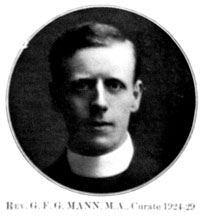 Without this initial help, so generously given, the commencement would have been hampered and much more difficult. Less than two years after the opening of the Church the work of supplying a Mission Hall was undertaken for a district in the Parish which was described in 1896 as "one of the worst in Belfast for drunkenness and all its attendant evils". Already Sunday School work and Mission Services were being carried on in houses rented in Hilland Street (now Hunter Street), and Eureka Street. In this new adventure Mr. Northridge had the devoted help of Mr. Andrew Forsyth as Scripture Reader, who with his wife are still remembered by some to whom their united ministry meant salvation in Jesus Christ. The Hall was opened on 11th October, 1898. The Lord Bishop presided, and the Hall was declared open by the Lord Mayor of Belfast. Regret was expressed at the absence of Mrs. Walkington whose generosity led to the starting of the Hall. The total cost of the building and site was £1,250, and the debt remaining after the opening ceremony amounted to £400. It is gratifying to note that this amount was paid off within twelve months. Thus the congregation had provided by self-sacrificing efforts premises which have proved a radiating centre of spiritual blessing to a district which could be improved in no other way.
Without this initial help, so generously given, the commencement would have been hampered and much more difficult. Less than two years after the opening of the Church the work of supplying a Mission Hall was undertaken for a district in the Parish which was described in 1896 as "one of the worst in Belfast for drunkenness and all its attendant evils". Already Sunday School work and Mission Services were being carried on in houses rented in Hilland Street (now Hunter Street), and Eureka Street. In this new adventure Mr. Northridge had the devoted help of Mr. Andrew Forsyth as Scripture Reader, who with his wife are still remembered by some to whom their united ministry meant salvation in Jesus Christ. The Hall was opened on 11th October, 1898. The Lord Bishop presided, and the Hall was declared open by the Lord Mayor of Belfast. Regret was expressed at the absence of Mrs. Walkington whose generosity led to the starting of the Hall. The total cost of the building and site was £1,250, and the debt remaining after the opening ceremony amounted to £400. It is gratifying to note that this amount was paid off within twelve months. Thus the congregation had provided by self-sacrificing efforts premises which have proved a radiating centre of spiritual blessing to a district which could be improved in no other way.
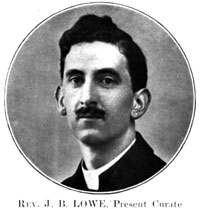 Thus was originated and set going the Work of God in the Parish of St. Aidan's, and Eternity alone will be able to reveal the far-reaching results. Inspired by unswerving loyalty to Jesus Christ and a resolute purpose to glorify Him, Mr. Northridge laboured faithfully in this arduous and responsible charge, and during his incumbency he had the joy of seeing many roused from their spiritual indifference and brought to a saving knowledge of Jesus Christ. To the inexpressible sorrow of a devoted people Mr. Northridge accepted a call to St. Thomas' Parish, Dublin, in November, 1902, having thus completed a ministry in St. Aidan's of nine and a half years. There he ministered with his accustomed zeal, until the Home-call came in the spring of 1910, and in a way which he himself would certainly have chosen, if that choice had been his, visiting a parishioner who was ill, he knelt at the bedside and in this attitude of prayer. comforting another, he passed into the presence of the King whom he loved and served so well. To the memory of Mr Northridge a beautiful triple light stained glass window representing Faith, Hope, and Charity, was erected by the parishioners and dedicated by the Lord Bishop of the Diocese on Sunday, 28th May, 1911.
Thus was originated and set going the Work of God in the Parish of St. Aidan's, and Eternity alone will be able to reveal the far-reaching results. Inspired by unswerving loyalty to Jesus Christ and a resolute purpose to glorify Him, Mr. Northridge laboured faithfully in this arduous and responsible charge, and during his incumbency he had the joy of seeing many roused from their spiritual indifference and brought to a saving knowledge of Jesus Christ. To the inexpressible sorrow of a devoted people Mr. Northridge accepted a call to St. Thomas' Parish, Dublin, in November, 1902, having thus completed a ministry in St. Aidan's of nine and a half years. There he ministered with his accustomed zeal, until the Home-call came in the spring of 1910, and in a way which he himself would certainly have chosen, if that choice had been his, visiting a parishioner who was ill, he knelt at the bedside and in this attitude of prayer. comforting another, he passed into the presence of the King whom he loved and served so well. To the memory of Mr Northridge a beautiful triple light stained glass window representing Faith, Hope, and Charity, was erected by the parishioners and dedicated by the Lord Bishop of the Diocese on Sunday, 28th May, 1911.
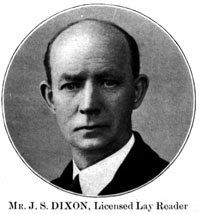 The Rev. J. H. Douglas, B.A., was appointed as successor to Mr.
Northridge in November, 1902. He had been associated with him as Curate in the work of the Parish, and brought to his more responsible position a rich experience, a ripe judgment, and an exceedingly sympathetic disposition. The Parish made progress under his guidance, but soon ill-health interrupted what had promised to become a fruitful ministry and after a prolonged illness he passed to his reward on the 24th October, 1905. His devotion, his faithfulness, his sincerity, his purity, his lofty ideals, but above all his passion to win souls for Jesus Christ, are still remembered by those upon whom his too brief ministry left an abiding impression. A handsome brass Mural Tablet has been erected in the Church, and a beautiful brass eagle Lectern, both gifts by the parishioners are fitting memorials of one who was greatly beloved.
The Rev. J. H. Douglas, B.A., was appointed as successor to Mr.
Northridge in November, 1902. He had been associated with him as Curate in the work of the Parish, and brought to his more responsible position a rich experience, a ripe judgment, and an exceedingly sympathetic disposition. The Parish made progress under his guidance, but soon ill-health interrupted what had promised to become a fruitful ministry and after a prolonged illness he passed to his reward on the 24th October, 1905. His devotion, his faithfulness, his sincerity, his purity, his lofty ideals, but above all his passion to win souls for Jesus Christ, are still remembered by those upon whom his too brief ministry left an abiding impression. A handsome brass Mural Tablet has been erected in the Church, and a beautiful brass eagle Lectern, both gifts by the parishioners are fitting memorials of one who was greatly beloved.
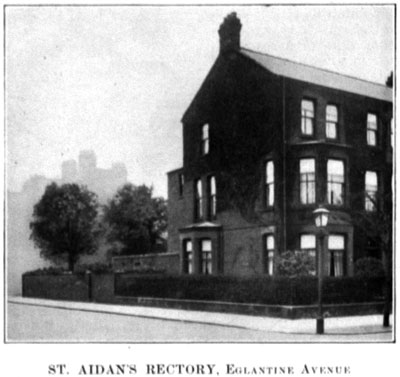
 The selection of a successor to Mr. Douglas fell upon the Rev. W.H.A. Lee, M.A., Rector of St. Donard's, where he had Iaboured with much acceptance for five years. He commenced his ministry in St. Aidan's on 17th December, 1905, and soon gave evidence of that determination and sincerity of purpose in the work of God which had marked his labours elsewhere. Under his faithful guidance the testimony of the church in the district to the great central verities, and social implications of the Gospel were resolutely maintained. Mr. Lee's appointment as Rector of Ahoghill brought his ministry in St. Aidan's to a close on the 5th July, 1911. The Rev. Louis W. Crooks, Curate of Willowfield, was instituted as successor to Mr. Lee on Friday, 25th August, 1911, by the Lord Bishop of the Diocese. Mr. Crooks came with a rich experience and matured knowledge of practical work in such a parish as St. Aidan's. He found a safe way through complex problem and during his ministry the money required to place the parish on the Diocean Scheme was raised early in the year 1918. Mr. Crooks was appointed to the Parish of Knockbreda. The vacancy thus created in the incumbency of St. Aidan's was filled by the appointment of the Rev. J.C. Rutherford, B.A. The institution of the new Rector took place In the church on Saturday, 30th March, 1918, at 4 o'clock, by the Lord Bishop of the Diocese. Mr. Rutherford had been ordained to the curacy of St. Aidan's in 1915, and had therefore intimate knowledge of the various activities of the parish. During his ministry the work of the parish made progress. In 1922 a scheme was inaugurated for the purchase of the site of the church and the renovation of the organ. This scheme was within sight of completion when Mr. Rutherford was appointed Incumbent of Willowfield in succession to the late Canon Harding. This vacancy was filled by the unanimous appointment of the Rector, Rev. Samuel J. Greer, who was instituted in the church by the Lord Bishop of the Diocese on Tuesday, 24th October, 1922.
The selection of a successor to Mr. Douglas fell upon the Rev. W.H.A. Lee, M.A., Rector of St. Donard's, where he had Iaboured with much acceptance for five years. He commenced his ministry in St. Aidan's on 17th December, 1905, and soon gave evidence of that determination and sincerity of purpose in the work of God which had marked his labours elsewhere. Under his faithful guidance the testimony of the church in the district to the great central verities, and social implications of the Gospel were resolutely maintained. Mr. Lee's appointment as Rector of Ahoghill brought his ministry in St. Aidan's to a close on the 5th July, 1911. The Rev. Louis W. Crooks, Curate of Willowfield, was instituted as successor to Mr. Lee on Friday, 25th August, 1911, by the Lord Bishop of the Diocese. Mr. Crooks came with a rich experience and matured knowledge of practical work in such a parish as St. Aidan's. He found a safe way through complex problem and during his ministry the money required to place the parish on the Diocean Scheme was raised early in the year 1918. Mr. Crooks was appointed to the Parish of Knockbreda. The vacancy thus created in the incumbency of St. Aidan's was filled by the appointment of the Rev. J.C. Rutherford, B.A. The institution of the new Rector took place In the church on Saturday, 30th March, 1918, at 4 o'clock, by the Lord Bishop of the Diocese. Mr. Rutherford had been ordained to the curacy of St. Aidan's in 1915, and had therefore intimate knowledge of the various activities of the parish. During his ministry the work of the parish made progress. In 1922 a scheme was inaugurated for the purchase of the site of the church and the renovation of the organ. This scheme was within sight of completion when Mr. Rutherford was appointed Incumbent of Willowfield in succession to the late Canon Harding. This vacancy was filled by the unanimous appointment of the Rector, Rev. Samuel J. Greer, who was instituted in the church by the Lord Bishop of the Diocese on Tuesday, 24th October, 1922.
With the commencement of the present ministry the unavoidable obligation came upon the church, by the legislation of the General Synod, to provide a Rectory, or pay an equivalent amount to meet the rent and taxes of the house occupied by the Rector. The Select Vestry very carefully considered the whole matter, and ultimately decided to purchase a house as an official residence, asking the Bank to advance the money, which could be repaid by the church. The admirable house in Eglantine Avenue was secured at a price which was considered reasonable, £1,480, which with legal expenses amounted to over £1,500. In addition to this heavy burden had to be added a debt of over £400 on the Current Account, which had accumulated during the past few years. With prayer for guidance and characteristic energy the task of removing this burden was faced : in less than two years £600 was paid off the debt, and an application to the Representative Church Body for a loan of the remaining £900, repayable by a fixed annual charge, over a period of years, was granted.
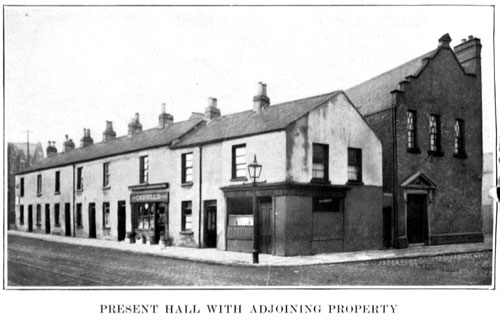
--------------------------------------------------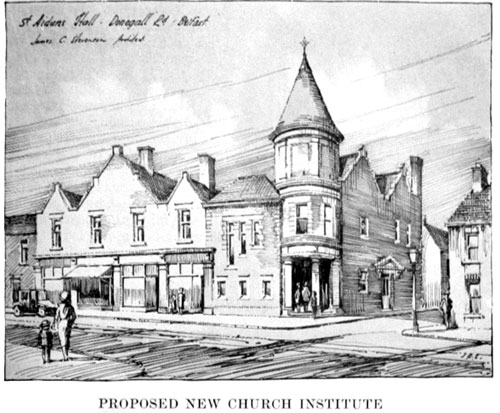
Clergymen who served as Curates in St Aidan's Parish :--
Rev. E. G. Burland, B.A., Dec. 1895.
Rev. E. G. Allworthy, M.A., Nov, 1898.
Rev. J. Warren, B.D., May, 1899.
Rev. J. H. Douglas, B.A., Oct., 1901.
Rev. R. R. Muir, B.A., July, 1903.
Rev. W. B. O'Kane, LL.B., Dec., 1903.
Rev. R. H. White, M.A., July, 1905.
Rev. Thomas Kelly, B.A., June, 1906.
Rev. Thomas Topley, L.TH., Jan.1910.
Rev. Charles P. Fisher, M.A., Dec., 1911.
Rev. John Redmond, B.A., Dec. 1912.
Rev. George A. Elliott, LL.D., July, 1913.
Rev.J. C. Rutherford, B.A., Dec., 1915.
Rev. Joseph Rs, B.A., March, 1919.
Rev. J. Coulter, June, 1919.
Rev. J. Frazer, B.A., May, 1921.
Rev. J. J. M'Corry, Nov., 1912.
Rev. R. J. Prole, June, 1924.
Rev. G. F. G. Mann, M.A., July, 1924.
Rev. J. B. Lowe, Sept., 1929.
--------------------------------------------------
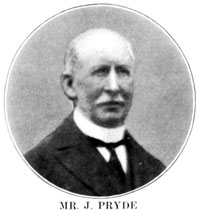 It is fitting that mention should be made at some outstanding helpers in the formation of St. Aidan's. First among these must be placed the Churchwardens. Mr. James T. Pryde and Mr. John Wallace. Mr. Pryde with his gifted wife, contributed in a way that can never be recorded to the success and advancement of the work. Their home at 77 Great Victoria Street was an "open door''', and bureau of good counsel for anyone connected with St. Aidan's, and the privilege so heartily offered was eagerly embraced.
It is fitting that mention should be made at some outstanding helpers in the formation of St. Aidan's. First among these must be placed the Churchwardens. Mr. James T. Pryde and Mr. John Wallace. Mr. Pryde with his gifted wife, contributed in a way that can never be recorded to the success and advancement of the work. Their home at 77 Great Victoria Street was an "open door''', and bureau of good counsel for anyone connected with St. Aidan's, and the privilege so heartily offered was eagerly embraced.
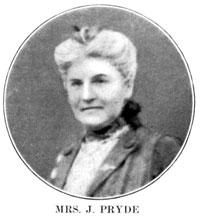 Mr. John Wallace acted as treasurer of the church for 14 years, and one can judge of his warm-hearted interest in the parish by repeated acts of generosity Intended to stimulate others. When deficits occurred on his accounts, as not infrequently happened, these were promptly settled by anonymous gifts, exactly the amount and marked "W." His practical concern in every activity of the church was in a hundred ways and touched every detail of the parish work. A beautiful Communion Table to his memory was placed in the church and dedicated on April 24th., 1924. It bears the following inscription :--"the gift of parishioners and friend, To the Glory of God and in memory of John Wallace, Esq., a generous benefactor of this parish."
Mr. John Wallace acted as treasurer of the church for 14 years, and one can judge of his warm-hearted interest in the parish by repeated acts of generosity Intended to stimulate others. When deficits occurred on his accounts, as not infrequently happened, these were promptly settled by anonymous gifts, exactly the amount and marked "W." His practical concern in every activity of the church was in a hundred ways and touched every detail of the parish work. A beautiful Communion Table to his memory was placed in the church and dedicated on April 24th., 1924. It bears the following inscription :--"the gift of parishioners and friend, To the Glory of God and in memory of John Wallace, Esq., a generous benefactor of this parish."
Mr. Thomas Smyth took up the treasurership of the Church from Mr. Wallace, and acted in that capacity for the long period of 17 years. No Church ever had a more faithful officer, and no clergyman a more loyal friend and helper. In recognition of his faithful services he was presented (on 12th September, 1924) with a beautiful solid gold watch and chain by parishioners and friends. Happily Mr. Smyth is still with us, one of our Nominations, and a member of our Select Vestry, and our prayer is that we may long enjoy the benefit of his wise counsel and helpful presence. A sturdy and uncompromising Protestant, Mr. Smyth was the prime mover in the formation of St. Aidan's Total Abstinence L.O.L. 1457, which commenced in July, 1894, and was among the first Total Abstainers' Lodges registered in Ireland.
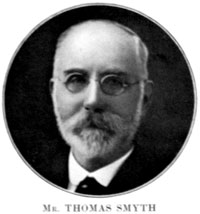 "The Home-call of Mrs. Greer, the wife of our beloved Rector, has come as a sad blow not only to her most intimate friends. but to all the parishioners of St. Aidan's, for Mrs. Greer was a real friend and helper in our parish. There is no organization in connection with the Church that did not benefit from her kind assistance and that did not feel her quiet influence from time to time. It will not be possible in this, or indeed in any article, to speak of all her work, for much of it was done in secret. But it is known to her Lord whom she so faithfully served.
"The Home-call of Mrs. Greer, the wife of our beloved Rector, has come as a sad blow not only to her most intimate friends. but to all the parishioners of St. Aidan's, for Mrs. Greer was a real friend and helper in our parish. There is no organization in connection with the Church that did not benefit from her kind assistance and that did not feel her quiet influence from time to time. It will not be possible in this, or indeed in any article, to speak of all her work, for much of it was done in secret. But it is known to her Lord whom she so faithfully served.
"Mrs. Greer was a devoted wife and loving adviser to her husband. She recognised always that her first duty in life was in her home, and there the Lordship of Jesus Christ was evident at all times. It soon became clear even to casual observers that Jesus Christ was a reality to her in the daily duties of life, and that work itself was hallowed by His Presence. One could never deny that the fragrance of the Lord was in the house where Mrs. Greer was and that it was her joy to reveal Him to those with whom she met or to whom she ministered.
 "But Mrs. Greer found time to serve her Lord in other fields also, and the parishes where her husband was called to minister felt, and still feel, the results of her efforts. ln the parishes of St. Paul's and St. Aidan's she was the leader of large Bible Classes for women, many of whom to-day have cause to call her blessed. The Bible to her was the Word of the living God, and a treasure without price in her life. Many were the spiritual lessons learned by those who attended her classes. Best of all there are those who can give humble testimony to the fact that it was in these classes that they first learned to know and love the Saviour.
"But Mrs. Greer found time to serve her Lord in other fields also, and the parishes where her husband was called to minister felt, and still feel, the results of her efforts. ln the parishes of St. Paul's and St. Aidan's she was the leader of large Bible Classes for women, many of whom to-day have cause to call her blessed. The Bible to her was the Word of the living God, and a treasure without price in her life. Many were the spiritual lessons learned by those who attended her classes. Best of all there are those who can give humble testimony to the fact that it was in these classes that they first learned to know and love the Saviour.
"Her love for lost souls was a characteristic feature about Mrs. Greer. How her face would light up with joy on being told of any one who had been brought to a personal knowledge of the Saviour. One could never weary her in conversation of such a sort. It was her delight to talk of Him and His work all the day.
"Prayer meant much to her who is gone. It was the breathing and outpouring of her soul to God. It was effectual, fervent prayer. If the parishioners of St. Aidan's only knew how Mrs. Greer prayed for them they might be well amazed. And how often prayer was answered, those who knew her best can tell.
Article in Parish Magazine, February, 1929, by G.F.G. Mann.
"What she thought about death could be gathered from the following poem which was found with her possessions some days after her Home-call :--
Passing out of the shadow
Into a purer light;
Stepping behind the curtain,
Getting a clearer sight.
Laying aside a burden,
This weary mortal coil;
Done with the world's vexations,
Done with its tears and toil.
Tired of all earth's playthings.
Heartsick, and ready to sleep;
Ready to bid our friends farewell,
Wondering why they weep,
Passing out the shadow
Into eternal day; --
Why do we call it dying --
This sweet going away?"
A marble Tablet from the members of her Bible Class and friends is being erected in the Church, and will be dedicated on Easter Day, 20th April, 1930, by the Lord Bishop.
SUNDAY SCHOOL work was commenced in St. Aidan's Parish on Monday, 11th June, 1893. The start was made in Linfield Mill School, and the work has been carried on with unbroken regularity for almost 37 years, so that to-day hundreds are scattered all over the world who received their first instruction in the Word of God, and their earliest impressions of Jesus Christ. from the lips of those devoted workers who have faithfully maintained this work through the years.The prosperity of this work was never more marked than to-day, and tokens of Divine favour and blessing are increasingly manifest. To properly accommodate the hundreds of children who crowd our schools is our immediate concern; the premises at our disposal are inadequate and wholly unsuited to the needs of such work. The conditions under which the work must be done seriously impair its effectiveness.
We are therefore seeking by this brief history to stress the urgent need to provide such buildings as may enable us to centralize not only our Sunday School work, but other parochial activities. The Sunday School work is the more pressing, and therefore we mention it first. With a view to this end the congregation of St. Aidan's have secured the property, comprising eight houses, adjoining our Mission Hall (as seen in picture), as a site for a Church Institute. We also give a picture of what has been suggested for our new buildings. No plans have as yet been definitely adopted, but the picture given presents a general idea of what we hope to achieve.

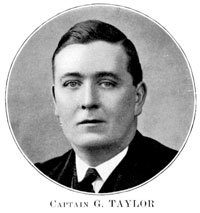 The Church Lads' Brigade was formed in February, 1905. Its first officers were Captain Magowan and Staff-Sergt. W. Chiplin, afterwards Captain. It has attained a record of good and useful service. During the captaincy of David Martin the Pipe Band (a picture of which Is given) was organized under Bandmaster Watson; which secured for the Company popularity far beyond the parish. On two occasions they were specially invited to attend the English Church Congress, at Norwich and Oxford. The Band was also honoured with a request to be present at the opening of Liverpool Cathedral. The present Captain, Mr. George Taylor (whose picture is given) has been connected with the Company for 21 years, first as a cadet, now as captain.
The Church Lads' Brigade was formed in February, 1905. Its first officers were Captain Magowan and Staff-Sergt. W. Chiplin, afterwards Captain. It has attained a record of good and useful service. During the captaincy of David Martin the Pipe Band (a picture of which Is given) was organized under Bandmaster Watson; which secured for the Company popularity far beyond the parish. On two occasions they were specially invited to attend the English Church Congress, at Norwich and Oxford. The Band was also honoured with a request to be present at the opening of Liverpool Cathedral. The present Captain, Mr. George Taylor (whose picture is given) has been connected with the Company for 21 years, first as a cadet, now as captain.
He is a faithful, patient and painstaking officer, and exceedingly popular with the boys.
During the Great War it was estimated that almost 1,000 men went forth from the parish in the service of King and Country: 79 of whom made the supreme sacrifice. To the memory of these men a large Marble Tablet has been placed in the church by the parishioners, on which their names are recorded.
Companies of Rangers, Guides and Brownies are doing good and useful work among the girls of the parish. The Captain of the Rangers is Miss V. Gilliland, under whose capable leadership these senior girls are often to be found busy doing some bit of parochial work with regularity, and without display. The Guides have an efficient captain in Miss M'Connell. Quite recently they showed how carefully they had been trained by winning the "Shearman Cup" for the best needlework. The competition was open to all companies in South Belfast. The Brownies have a most painstaking officer in Miss Wilkinson, who is faithful in her care and attention of the little ones.
Bible Classes are held weekly for women, young women, men, and boys. These are well attended, and perhaps no part of our parochial work is more decidedly encouraging than this.
Christian Endeavour Societies were formed in the parish by the Rev. J. Northridge in September, 1895. Since then there was a period of years when they had ceased to operate. They were re-started some years ago, and the re-opening has been more than justified. Both the Senior and Junior Societies have proved invaluable as a training-ground for young people in the service of Christ and His Church. The Senior Society has found teachers for our Sunday Schools, tract distributors, and those who regularly take flowers and fruit to sick ones, helpers in open-air work. And here practical interest in Missionary work is fostered and helped by prayers and gifts. It is recorded with gratitude that seldom are any Endeavourers absent from Holy Communion, and Prayer Meetings, or any work of ministering to needy ones, they are always willing and advance helpers.
The Mission Hall has become a centre of definite mission work in the needy district in which it is situated, and during the past few years increasing blessings have rested on the services on Sunday and Tuesday evenings. The attendance's have continued to increase until the hall is quite full, and the most gratifying feature of this deepened interest that it is amongst those who had lost touch with organized religion and become Indifferent. The financial position of the Mission Hall has also improved; previously it had been a heavy annual charge on the parish; now through the voluntary gifts of the workers and offerings the expenses fully met. For this satisfactory state of things we owe much to the faithful work of Mr. G. Cooke, and our devoted band of helpers . . . . . . From St. Aidan's Church workers have gone forth to fuller service for Jesus Christ elsewhere. Miss Keith to Warsaw, where she has been working for many years with success and blessing among "God's own people", Rev. Benjamin P. Smyth, whose picture is given, in the first instance went to Wycliffe College, Toronto, where he had a distinguished career, afterwards volunteering for pioneer Missionary work in the Canadian Arctic. Mr. Smyth is almost three years in Baffin's Land doing fruitful service among the Eskimos; William Larmour to the London City Mission, where he is doing successful work; George Waterman to the Church Army as C.A. Captain, is an acceptable lay work in an English parish; Samuel T. Coulter is now over two years in Emmanuel College, Saskatoon, preparing for the Ministry of the Canadian Church, under the Colonial and Continental Missionary Society; Miss Rhoda Smith to the Faith Mission Training College, Edinburgh.
Mr. T.J. Gray, the popular Secretary of the Church of Ireland Young Men's Society, is a member of St. Aidan's Church, and until his appointment was an earnest worker in the parish and Secretary of the Select Vestry.
OUR story is told, and it has been told to excite practical interest, and evoke prayerful sympathy in the work of the parish. St. Aidan's Church stands, as it has always stood, loyal to the great principles of the Church of Ireland, Protestant and Reformed, and seeking to grapple with the complex problems by which it is faced, by the simple presentation of the Gospel of Jesus Christ, convinced that this alone can meet the profoundest and widest prayer of the human heart. To this great central aim every parochial activity is subordinate and incidental. This we go forward with fixed hope; though we know the pressure of the burden, and the apparent strength of sin, yet these are but symptoms of a day. God is moving towards victory. May we be fellow-workers with Him.
The following gifts have been presented to the Church:-- Presented by W.T. Coates, Esq., Full Service of Communion Plate, 1893; Carved Oak Pulpit (photo given), presented by William Baird, Esq., J.P., Avonmore, Fortwilliam Park, in memory of his mother, February, 1895; Bible, Prayer and Service Books and Communion Linen by James T. Ward, Esq., February, 1895; Font by the Rector and Select Vestry of St. James' Church, Belfast, February, 1895; Choir Seats by the Rector and Select Vestry of St. Thomas' Church, Belfast, February, 1895; Eight Carved Oak Collecting Plates by Mr. and Mrs. Andrew Mitchell, March, 1897; Two Bells as a Thankoffering by a friend, Easter, 1902; One Bell, by T.J. Raubb, Esq., 1902; Brass Book Rest for Communion Table by Sergt. and Mrs. James, 11th Oct., 1914; Memorial Stained Glass Window erected by Miss N. Moore in memory of the late Thomas Moore, one of our C.L.B. boys, killed in France, 8th September, 1918; Solid Oak Chancel Seat, Thankoffering by A.W. Mann, Esq., 1927; Solid Oak Hymn Boards with Requisite Figures by Messrs. J. Graham and R. Stewart.
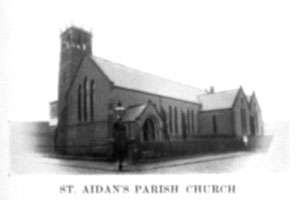
WE convey our sincere thanks to many friends for information given concerning "past days," without which this brief history would have been impossible. But especially would we acknowledge the valuable help given by Mr. R.M. Sibbett, who holds such a deservedly distinguished position in the journalistic profession of Belfast, for his most interesting resume of the history of South Belfast a century ago, and in his own inimitable way linked up the past with the present, providing us with the data that makes up the interesting background of this story. We tender to Mr. Sibbett our sincere and hearty thanks.
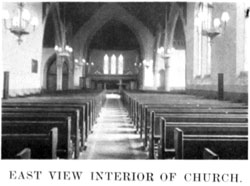
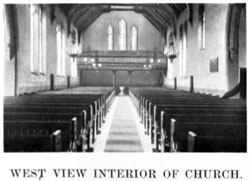
Parish Church of St. Aidan, Belfast
RECTOR:
REV. SAMUEL J. GREER, St. Aidan's Rectory, Eglantine Avenue.
CURATE:
REV. J. B. LOWE, 5 Sandhurst Drive.
LAY READER:
MR. J. S. DIXON, 8 Tate's Avenue.
CHURCHWARDENS:
Messrs. R. STEWART and J. COLLINS.
TREASURER:
Mr. J. COLLINS, 17 Iverna Street.
ORGANIST:
Mr. EDWARD HOGG. 2 Beechmount Park, Finaghy.
--------------------------------------
SERVICES.
Sunday Services:
Morning Prayer. 11-30.Evening Prayer, 7-0
Mission Service -- Tierney Street Hall, 7 o'clock.
Sunday Schools:
Morning, 10-15;Afternoon, 3 o'c., in Schoolhouse, Blythe Street,
and In Mission Hall, Tierney Street.
Bible Classes: Men's in Church, C.L.B's. in School, on Sunday mornings at 10-15.
Holy Communion:
First Sunday at 11-30. Third Sunday at 7-0.
Church Festivals.
Holy Baptism: Every Wednesday evening at 7, and as arranged
Monday: Women's Bible Class in Mission Hall at 8.
Tuesday:
Mission Service in Mission Hall at 8.
Girl Guides in School at 7-30.
Wednesday: Service in the Church at 8. Choir Practice at the close of Service.
Thursday:
Church Lads' Brigade in School at 8. Y.P. Society of Christian Endeavour
in Mission Hall at 8. Junior Christian Endeavour at 7.

